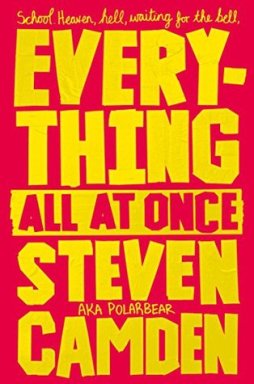Today on the blog, I’m reviewing some POETRY.
 Author(s): Steven Camden
Author(s): Steven Camden
Publisher: Macmillan
Publication date: 12th July 2018
Source: I received a NetGalley copy of this book in exchange for an honest review. Any quotes taken from this copy may be subject to changes in final editions.
Find on Goodreads and The Book Depository
One week. One secondary school. Hundreds of teenagers. Forty-two poems.
Zooming in across a cast of characters over the course of just five days, this collection illuminates a kaleidoscope of teenage moments. From fitting in, finding friends and falling out, to lessons, losing out and losing it, to worrying, wearing it well and worshipping from afar.
There is a mythical dream tied to writing poetry aimed at young adults, and that is to make poetry cool. Such is the raison d’etre of acclaimed spoken word poet Steven Camden’s second book for young people of the year, Everything All At Once. It’s splashed all over the book: in the shouty cover, in the slang, in the Stormzy references. There must be a powerful pull to the promise of glory that would follow if you were the one who solved, once and for all, that strange equation, defined the inscrutable, ever-shifting property that is cool poetry. If you were to convince a whole target audience, who often only encounter poetry when it seems blunted into some kind of torture device – modern but laid out for dissection in revision materials and examination papers, important but deliberately pulled from the dustiest book on the shelf – that actually, poetry can be relevant and enjoyable.
Set at a busy, mutable comprehensive – the message clearly that it could be any school, anyone’s school – the book presents a cross-section of quickly-sketched characters, from year sevens to school-leavers (“Funny to think / I was ever / that small”). Some names recur. Some figures aren’t named. Many appear, at least identifiably, for only one poem, as in the case of Yusuf, who pretends not to speak French well in order to better fit in, despite his mother being from Toulouse. The work flits from one poem to the next, one perspective to the next, usually in first person. As if to further say: look, you could write this. A football match can be worthy of a poem. Even if you’re no good at exams or like to make things with your hands. You could read poetry, too.
From the ordinary (“Shauna said that / Leia said that / Jordan said it’s over / He changed his status yesterday / before he even told her”) to the startling (“a gaggle of mad daggering laminate features”), the poems are energetic, rapid-fire, staccato. As it strives to capture the bizarre microcosm that is secondary school society, the language is often mundane and the imagery sometimes vague, but I imagine it sounds great out loud. Hurtling along at a breakneck 128 pages, some of my favourite pieces included “Vending Machine”, “New Guy”, and “Parting Thought”.
Everything All At Once is more of a novel-in-verse than a collection, but there isn’t much of a plot, it can sometimes be tricky to follow, and it doesn’t delve that deeply into any of the themes or issues it raises. I’m not sure that it will transform poetry, either, given its very school setting, its try-hard nature. It will go down well in classrooms or workshops; it will certainly fit projects like Sarah Crossan’s ‘We Are The Poets’ laureateship. It probably won’t have the ‘organic’ feel of contemporary poets like Rupi Kaur or Amanda Lovelace whose digital, personal strategies persuade audiences, especially young women (who are somewhat sidelined in favour of a majority-masculine cast here) that subversive poetry, cool poetry, occurs outside the school gates, but it’s a fast-paced, dynamic effort.

For fans of Sarah Crossan, Phil Earle and Benjamin Zephaniah, this novel-in-verse delivers on its premise. It lacks plot, but there are some energetic poems within its pages.


 Author(s): Mary Bello, Aisha Bushby, Tanya Byrne, Inua Ellams, Catherine Johnson, Patrice Lawrence, Ayisha Malik, Irfan Master, Musa Okwonga, Yasmin Rahman, Phoebe Roy, Nikesh Shukla, Lucy Banaji (illustrator)
Author(s): Mary Bello, Aisha Bushby, Tanya Byrne, Inua Ellams, Catherine Johnson, Patrice Lawrence, Ayisha Malik, Irfan Master, Musa Okwonga, Yasmin Rahman, Phoebe Roy, Nikesh Shukla, Lucy Banaji (illustrator)




 Author(s): Sarah Crossan, Brian Conaghan
Author(s): Sarah Crossan, Brian Conaghan

 Author: Sara Barnard
Author: Sara Barnard

